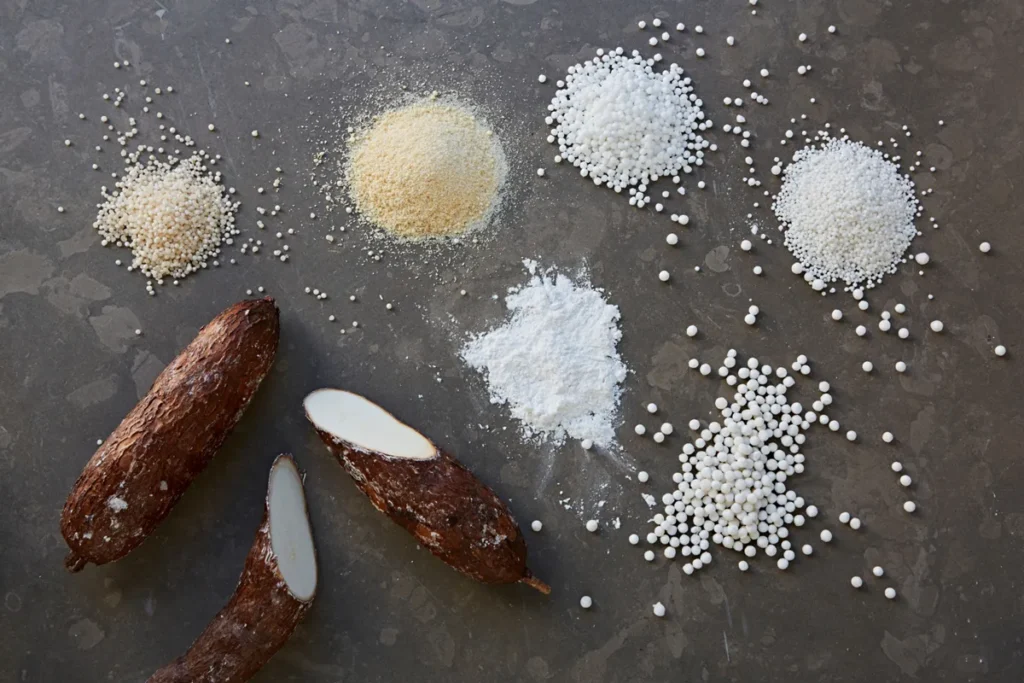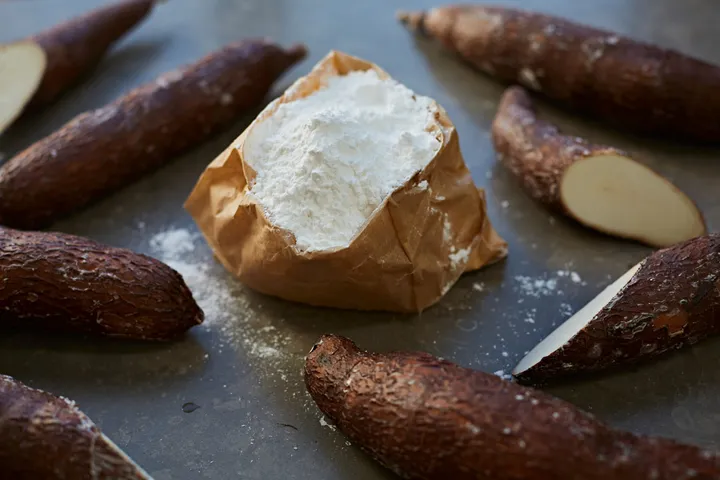Tapioca has a mild, slightly sweet taste with a neutral flavor. It’s not overpowering, allowing it to blend well with other ingredients.
Tapioca pearls, commonly used in bubble tea, have a chewy texture when cooked, adding a fun element to beverages. Tapioca flour, another form, is often used in gluten-free cooking.
Its taste is versatile, making it suitable for both sweet desserts like tapioca pudding and savory dishes. Overall, tapioca’s gentle sweetness and adaptable flavor make it a popular and enjoyable ingredient in a variety of culinary creations around the world.
What is tapioca?

Tapioca is a starchy substance derived from the roots of the cassava plant (Manihot esculenta). It serves as a versatile ingredient in various culinary applications, known for its neutral flavor and unique texture.
How is it made?
Tapioca is made from cassava roots. Farmers collect the roots of the cassava plant, which is a tropical plant grown in many parts of the world.
The outer skin of the cassava roots is removed to reveal the starchy part inside.
The cleaned cassava is shredded or grated into small pieces.
The grated cassava goes through a process to take out the starchy liquid. This involves pressing or squeezing the pieces to get the starchy content.
This starchy liquid is left to sit, and the starch settles down at the bottom.
If making tapioca pearls, the extracted starch is shaped into small balls and cooked. Sometimes, they’re dried for longer shelf life.
For tapioca flour, the extracted starch is dried using heat and then ground into a fine powder.
Tapioca can be made on a large scale in factories with machines or on a smaller scale at home with simpler methods.
Why is tapioca known for its chewy texture?
Tapioca gets its chewy feel because of something called gelatinization. Gelatinization happens when you cook tapioca pearls. These pearls come from cassava, a plant with starch that plays a big part in making tapioca chewy.
When you cook tapioca pearls, the starch in them soaks up water and swells. This makes the starch form a structure that gives the pearls their special chewy texture when you bite into them.
The chewiness of tapioca makes it great for many kinds of foods, like the pearls you find in bubble tea or in tapioca pudding. People like the chewiness, and it’s why tapioca is used in lots of different dishes around the world.
How would you describe the taste of tapioca?
Tapioca tastes a bit sweet and mild. It doesn’t have a strong flavor, so it goes well with different kinds of foods, whether they’re sweet or not.
Mild Sweetness
Tapioca has a bit of sweetness that comes from the natural sugars in the cassava plant. This sweetness is not too strong, giving tapioca a gentle sweet taste.
Because tapioca is mildly sweet, it’s great for desserts like puddings and bubble tea. It adds a touch of sweetness without being too overpowering.
Not Strong-Tasting
Tapioca doesn’t have a strong taste of its own. It’s like a blank canvas, which means it can take on the flavors of other things you mix it with.
Because tapioca doesn’t have a strong taste, you can use it in lots of different recipes. It can fit in with both sweet and savory dishes, adapting to the flavors around it.
Goes Well with Different Flavors
Tapioca’s mild flavor goes well with all sorts of tastes. It doesn’t overpower other flavors, making it good for recipes where you want a nice mix of different tastes.
When you use tapioca, it adds a nice texture without taking over the main flavors. It works well in both sweet and savory dishes without standing out too much.
How is Tapioca Used in Cuisine?
Tapioca is used in different ways in cooking. People make yummy desserts like tapioca pudding and use tapioca pearls in drinks like bubble tea to add a fun chewy texture.
Popular Dishes that Use Tapioca
Tapioca Pudding
Tapioca pudding is a classic dessert made by cooking tapioca pearls with milk, sugar, and often vanilla. The pearls absorb the creamy mixture, creating a delightful texture in the pudding.
Bubble Tea
Tapioca pearls, also known as boba, are a key component in bubble tea. These chewy pearls are added to various tea and milk-based beverages, creating a fun and textured drink experience.
Brazilian Tapioca Crepes
In Brazil, tapioca flour is used to make traditional crepes. These crepes are often filled with sweet or savory fillings, showcasing the versatility of tapioca in different culinary contexts.
Thai Tapioca Desserts
Thai cuisine incorporates tapioca in various desserts, such as Tapioca Pudding with Coconut Milk. Tapioca pearls are simmered in coconut milk, creating a creamy and flavorful sweet treat.
Filipino Tapioca Snacks
In the Philippines, “Taho” is a popular street food made with sweet arnibal syrup, sago pearls (similar to tapioca), and silken tofu. It’s a delicious and comforting snack.
Role in Different Cuisines
Asian Cuisine
Tapioca pearls are widely used in Asian cuisine, particularly in desserts and beverages. Apart from bubble tea, they are featured in various sweet soups, puddings, and icy treats in countries like Taiwan, China, and Thailand.
Brazilian and South American Cuisine
In Brazil, tapioca flour is a staple in making “tapioca crepes” filled with ingredients like cheese, coconut, or chocolate. It’s a popular and versatile street food that showcases the cultural adaptability of tapioca.
Indian Cuisine
Tapioca is used in Indian cuisine to make dishes like Sabudana Khichdi, a savory and spiced tapioca pearl preparation. Tapioca’s unique texture adds an interesting dimension to both sweet and savory Indian recipes.
American Desserts
In the United States, tapioca is a key ingredient in the classic tapioca pudding. Its ability to absorb flavors and provide a delightful texture makes it a cherished element in American dessert traditions.
Global Gluten-Free Cooking
Tapioca flour is often used in gluten-free cooking and baking as a substitute for wheat-based flours. It adds a light and airy texture to gluten-free recipes, making it an essential ingredient for those with gluten sensitivities.
What are tapioca pearls?

Tapioca pearls are made from tapioca starch, which is extracted from the roots of the cassava plant. The starch is mixed with water to form a dough, and then small pearls are shaped from this dough.
These pearls are then cooked until they achieve a chewy texture, resulting in the well-known tapioca pearls used in various culinary applications.
How tapioca pearls are used in bubble tea?
Bubble tea, also known as boba tea, is a popular beverage that originated in Taiwan. Tapioca pearls are a key ingredient in bubble tea, contributing to its name. The pearls are typically added to the bottom of the drink, and they settle at the base of the cup.
Tapioca pearls are cooked until they reach a chewy consistency. They are then cooled and sometimes soaked in a sweet syrup or honey to enhance their flavor.
When making bubble tea, a layer of tapioca pearls is placed at the bottom of a cup. This forms the “bubbles” or “boba” in the drink.
The tea base, which can be black or green tea, flavored tea, or a milk tea variant, is then poured over the tapioca pearls.
Sweeteners like sugar or flavored syrups are often added to the tea for sweetness. Ice is also commonly included to create a refreshing and chilled beverage.
The drink is usually shaken or stirred to mix the tea, sweetener, and ice, creating a harmonious blend of flavors.
A wide straw is used to enjoy both the liquid and the tapioca pearls together. The unique appeal of bubble tea lies in the combination of sipping the flavored tea while also chewing on the chewy tapioca pearls.
Bubble tea comes in various flavors and styles. Some variations include fruit-flavored teas, milk teas, and blended beverages, all of which can be customized to personal taste preferences.
FAQ
Is tapioca sweet?
Tapioca has a mild, slightly sweet taste. Its natural sweetness is subtle and not overpowering, allowing it to be versatile in various dishes.
Is boba halal or haram?
Whether boba is halal or haram depends on the specific ingredients and preparation methods. It’s essential to check the sourcing and processing to determine its adherence to halal dietary guidelines.
Is tapioca tasteless?
Tapioca itself is not tasteless. It has a neutral flavor, making it adaptable to different recipes. However, tapioca pearls can absorb the flavors of the liquids they are cooked in.
Is it OK to eat tapioca balls?
Yes, it is safe to eat tapioca balls. These chewy pearls are a common ingredient in desserts and beverages like bubble tea, providing a unique and enjoyable texture.
Is it OK to swallow tapioca?
Yes, it is okay to swallow tapioca. The pearls are meant to be chewed for their distinctive texture, but swallowing them whole is generally safe.
Why is tapioca so chewy?
Tapioca becomes chewy through a process called gelatinization during cooking. The starch in tapioca pearls absorbs water, creating a pleasant and elastic texture.
Is undercooked boba bad?
Undercooked boba may have an unpleasant texture and could be challenging to chew. Proper cooking ensures the desired chewiness and eliminates any raw taste.
Is boba made of tapioca?
Yes, boba is made of tapioca starch. Tapioca pearls, also known as boba, are created from tapioca starch and are a popular addition to bubble tea.
Why is tapioca popular?
Tapioca is popular due to its versatile nature, neutral taste, and chewy texture. It is used in various global cuisines, particularly in desserts and bubble tea, contributing to its widespread appeal.
Final words
Tapioca has a gentle, slightly sweet taste that isn’t too strong. Its neutral flavor makes it a great fit for sweet treats like tapioca pudding or drinks like bubble tea.
Whether chewy tapioca pearls or versatile tapioca flour, it’s liked for its adaptability in both sweet and savory dishes. Tapioca’s subtle sweetness adds a pleasant touch to various recipes, making it a popular and enjoyable ingredient worldwide.

